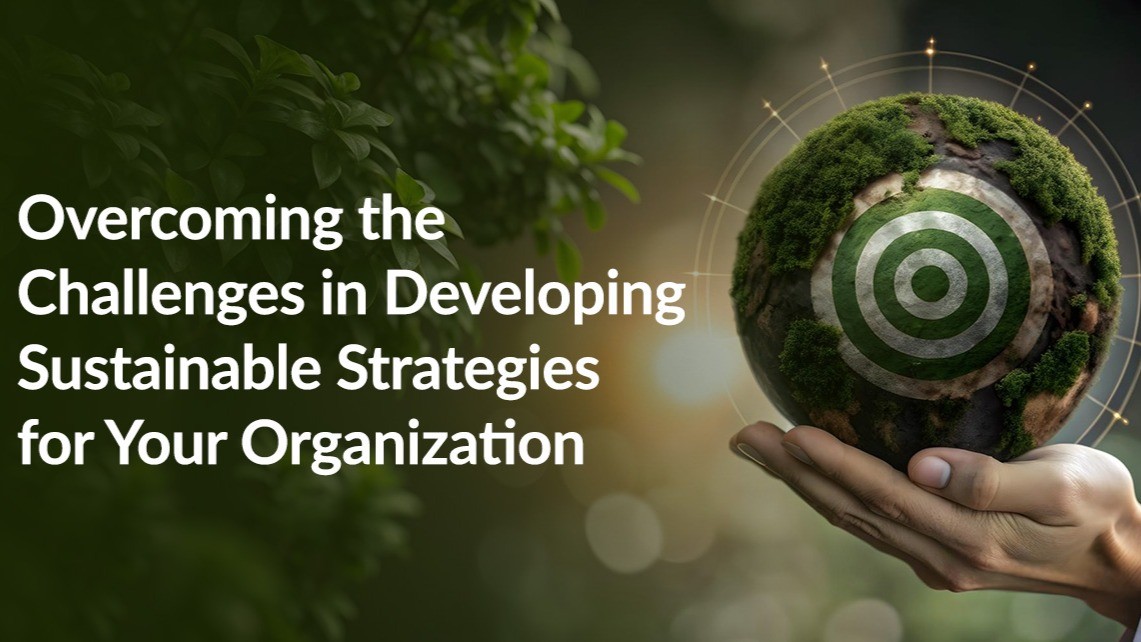Lack of Clear Vision and Strategy Alignment
The Challenge
One of the biggest hurdles in developing a sustainable strategy is the absence of a clear, long-term vision that aligns with the organization’s broader business goals. Sustainability efforts often become isolated initiatives rather than integrated elements of the company’s overall strategy. This disconnect can lead to conflicting objectives, where sustainability goals are sidelined in favor of short-term financial gains.
The Solution
Start by creating a clear sustainability vision that ties into your company’s core mission and values. Ensure that this vision is communicated across all departments so that every aspect of the organization aligns with the sustainability agenda. Sustainability should not be an afterthought but a guiding principle that informs business decisions, product development, supply chain management, and customer engagement.
To align the entire organization with this vision, consider establishing a cross-functional sustainability task force. This team can be responsible for developing key performance indicators (KPIs) that link sustainability targets with business outcomes, ensuring that sustainability initiatives drive both environmental and economic value.
Limited Resources and Budget Constraints
The Challenge
Many organizations, particularly small and medium-sized enterprises (SMEs), struggle with the perceived cost of sustainable practices. Investments in renewable energy, waste reduction technologies, or circular business models may seem out of reach for companies operating on tight budgets. Furthermore, sustainability initiatives can sometimes require up-front investment before realizing financial returns, creating additional hesitancy.
The Solution
Organizations can address this challenge by adopting a phased approach to sustainability. Instead of overhauling the entire business model at once, start with small, achievable projects that provide measurable results. For example, reducing energy consumption in facilities or optimizing waste management processes are low-cost initiatives that can lead to immediate cost savings.
Additionally, leverage government incentives and grants that support sustainability efforts. Many countries offer financial assistance for companies investing in renewable energy, energy-efficient equipment, or sustainable R&D projects. These incentives can significantly reduce the financial burden of adopting sustainable practices.
Finally, focus on long-term financial benefits. Sustainability can lead to increased operational efficiency, lower costs, and access to new markets. Communicate these potential returns to stakeholders and investors to gain buy-in for sustainability investments.
Complex Supply Chains and Lack of Transparency
The Challenge
In today’s globalized economy, supply chains often span multiple countries, with numerous suppliers and subcontractors involved at every stage of production. This complexity can make it challenging to ensure that sustainability practices are upheld throughout the entire supply chain. Issues such as unethical labor practices, excessive waste, and carbon emissions may go undetected if there is a lack of transparency.
The Solution
Supply chain sustainability requires collaboration, transparency, and the use of technology. Start by mapping out your entire supply chain to identify key areas where sustainability risks exist. Once the risks are identified, work closely with suppliers to set sustainability standards and expectations. This can involve creating supplier codes of conduct that enforce sustainable and ethical practices.
Invest in digital tools and platforms that enhance supply chain visibility. Many companies are now using blockchain technology to trace the origins of products and materials, ensuring that sustainability claims are verifiable. Partnering with suppliers who share your sustainability values will help create a resilient and transparent supply chain.
Resistance to Change
The Challenge
Sustainability often requires changes in mindset, behavior, and operations, which can be met with resistance from employees, management, or stakeholders who are accustomed to the status quo. Without proper engagement and buy-in, sustainable strategies can fail to gain traction within the organization.
The Solution
Engage employees, leaders, and stakeholders from the very beginning. When sustainability is viewed as a shared responsibility, people are more likely to embrace new initiatives. Foster a company culture that promotes sustainability by offering training, resources, and incentives to employees at all levels.
Clear and transparent communication is also essential. Explain the rationale behind sustainable strategies, showing how they align with the company’s long-term goals and how individuals and departments can contribute. Recognizing and celebrating sustainability champions within the organization can also create a positive feedback loop and encourage widespread participation.
Consider using storytelling to convey the impact of sustainability initiatives. Sharing success stories—both within and outside the organization—can demonstrate the tangible benefits of sustainability efforts, from reduced costs to enhanced brand reputation.
Difficulty in Measuring Impact
The Challenge
Many businesses struggle to measure the impact of their sustainability initiatives accurately. Without clear metrics, it can be challenging to assess whether sustainability efforts are delivering the desired results or to identify areas for improvement. This lack of data can also make it difficult to communicate the value of sustainability to stakeholders.
The Solution
Develop a robust measurement framework using well-established sustainability metrics such as those provided by the Global Reporting Initiative (GRI) or the Greenhouse Gas (GHG) Protocol. These frameworks offer standardized methods for tracking and reporting on various sustainability indicators, such as energy use, carbon emissions, and waste reduction.
Incorporate KPIs related to sustainability into your overall performance tracking system. These could include emissions reductions, cost savings from energy efficiency measures, or the percentage of waste diverted from landfills. Regularly review these metrics to track progress, and use the data to refine your sustainability strategy over time.
Reporting on sustainability metrics should also be a priority. Share your progress with internal and external stakeholders, including employees, investors, customers, and regulators. Transparent reporting helps build trust and accountability, while demonstrating leadership in sustainability.
Keeping Up with Evolving Regulations and Standards
The Challenge
Sustainability regulations and standards are constantly evolving, with governments and international bodies introducing new rules related to emissions, resource use, and environmental impact. Staying compliant with these regulations can be a challenge, especially for businesses operating in multiple regions.
The Solution
Assign a dedicated team or sustainability officer to stay updated on the latest regulatory requirements and standards in your industry. This team can monitor developments at local, national, and international levels and ensure that your organization remains compliant with emerging laws and guidelines.
Proactively adopting best practices and adhering to international standards, such as ISO 14001 (Environmental Management) or the Science Based Targets initiative (SBTi), can help future-proof your business against upcoming regulations. Collaborating with sustainability consultants, like Fuller Academy, can also provide the expertise and insights needed to navigate the complex landscape of sustainability regulations.
Developing and implementing sustainable strategies is no longer optional for businesses—it’s essential for long-term success. While the challenges may be significant, they are not insurmountable. By addressing these common hurdles—whether through fostering a clear vision, collaborating with suppliers, or leveraging new technologies—your organization can create a sustainability roadmap that drives both environmental and economic value.
At Fuller Academy, we specialize in helping businesses overcome these challenges and build effective, long-lasting sustainability strategies. Whether you’re just starting on your sustainability journey or looking to refine your existing initiatives, we offer tailored guidance and support.
Ready to take the next step in your sustainability journey? Contact us today for expert advice on developing and implementing a sustainable strategy that works for your business. Let’s shape a greener, more resilient future together.


